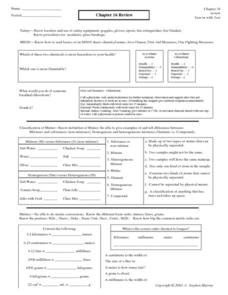Curated OER
Review Sheet for Covalent Compound Quiz
In this covalent compounds activity, students name 6 compounds given their chemical formulas, they write the formulas for 6 compounds given their chemical names and they answer questions about boiling points and solubility. They write...
Curated OER
Intermolecular Forces
In this intermolecular forces activity, students perform a simple experiment with water to observe the intermolecular forces that hold water together as they fill a beaker as much as possible. They explain the results of their...
Curated OER
Practice Sheet: Colligative Properties
For this colligative properties worksheet, students solve eight problems. They calculate molarity, molality and grams of substances in addition to using colligative properties to calculate solutions.
Curated OER
Intermolecular Force Worksheet
In this intermolecular force worksheet, students identify the molecules with the strongest intermolecular forces and explain how they determined this. They also predict boiling points and vapor pressure based on intermolecular forces of...
Curated OER
Chemistry Worksheet-Phase Changes
In this phase change instructional activity, students answer twenty questions about changes in energy to a system. They analyze phase diagrams, the determine the effects of changes in temperature on a system, they answer questions about...
Curated OER
Amines
For this amines worksheet, students solve 7 problems including classifying given structures, ranking them based on their boiling point, and naming structures.
Curated OER
Temperature Change and the States of Matter
Tenth graders observe the processes of evaporation, condensation, melting, freezing, boiling, and sublimation. They do a quantitative investigation of the freezing of water, to explore explanations that involve particles.
Curated OER
Ionic Compounds
In this compounds instructional activity, students review the structure and properties of ionic compounds, their formulas and nomenclature, and molecular mass and percentage composition. This instructional activity has 4 short answer...
Curated OER
Chemistry E3 Lesson Plan
Ninth graders perform a series of experiment to investigate heat transfer and phase changes. In this physical science lesson, 9th graders identify and calculate the different subatomic particles. They explain the importance of scientific...
Curated OER
Characteristics of Crystals
In this crystals worksheet, students complete a graphic organizer by filling in the characteristics of the different crystal types including melting/boiling point and electrical conductivity.
Curated OER
A Watched Pot Never Boils
Young scholars determine how long it takes to bring a specific amount of water to a rolling boil. Students conduct this experiment at home with their parent or guardian. Young scholars write down observations as the water begins to boil....
Curated OER
Comparing Properties of Elements & Compounds
In this elements and compounds worksheet, students review the physical properties of different compounds and elements using websites for information. This worksheet has 1 graphic organizer and 1 short answer question.
Curated OER
Is it Ionic?
For this ionic compounds worksheet, students are given clues about compounds such as their physical and chemical properties in order to determine if they are ionic compounds. Students indicate which compounds are ionic and which are not.
Creative Chemistry
Physical and Chemical Trends in the Group 7 Elements
In this elements worksheet, students complete a graphic organizer by comparing the elements' melting point, boiling point, density, and electronic configuration. Students determine the characteristics of Group 7 elements. This worksheet...
Creative Chemistry
Alkanes: Physical Properties
For this alkanes worksheet, students complete a graphic organizer by filling in the number of carbon atoms for the given alkanes. Kids plot a graph showing how physical properties change with the number of carbon atoms. Then, students...
Creative Chemistry
Haloalkanes: Physical Properties
For this gas activity, students use data tables to compare the density and boiling points of given haloalkanes to complete three short-answer questions.
Creative Chemistry
Evidence for Hydrogen Bonds Boiling Points of Various Compounds
For this hydrogen bonds worksheet, students create three graphs for comparison using three data tables showing the boiling points for various compounds containing hydrogen.
Creative Chemistry
Alkanes and Alkenes
In this alkanes activity, students use a data table to plot a graph of boiling point against the number of carbon atoms. They also define cracking and double bonds. This activity has five short answer questions.
Creative Chemistry
Physical Properties of Group 1 Elements
In this elements worksheet, learners complete a graphic organizer by filling in the symbol and atomic number for the given elements. Students plot a graph of melting point against atomic number. Learners write the electron arrangements...
Curated OER
Changing State
Students investigate the cooling and heating of water. In this online science experiment lesson, students work in groups to make predictions regarding freezing and boiling points and then test those predictions as they complete the...
Curated OER
Water Unit
In this water learning exercise, students review the properties of water including the density, boiling point, and evaporation. Students define mixture, solute, and solvent. This learning exercise has 22 short answer questions.
Curated OER
Chapter 16 Review- General Science
In this review of general science activity, students classify examples of matter as mixtures or substances, homogeneous or heterogeneous mixtures, or elements or compounds. Students also convert several examples using the standard units...
Curated OER
Behavior of Liquids and Gases
In this liquids and gases worksheet, students review 9 vocabulary terms associated with liquids and gases by completing a crossword puzzle.
Curated OER
Freezing and Boiling Point
In this freezing and boiling point graph learning exercise, students use the graph illustrated to respond to several questions that follow. They identify what is the freezing, boiling, and melting point of the substance in the graph....























